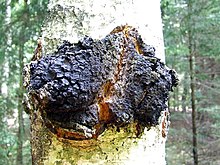Inonotus obliquus
| Inonotus obliquus | |
|---|---|

| |
| Scientific classification | |
| Domain: | Eukaryota |
| Kingdom: | Fungi |
| Division: | Basidiomycota |
| Class: | Agaricomycetes |
| Order: | Hymenochaetales |
| Family: | Hymenochaetaceae |
| Genus: | Inonotus |
| Species: | I. obliquus
|
| Binomial name | |
| Inonotus obliquus | |
| Synonyms[1] | |
|
Boletus obliquusAch. ex Pers. (1801) | |
Inonotus obliquus,commonly calledchaga(/ˈtʃɑːɡə/;aLatinisationof the Russian wordчага), is afungusin the familyHymenochaetaceae.It isparasiticonbirchand other trees. The sterileconkis irregularly formed and resembles burnt charcoal. It is not thefruiting bodyof the fungus, but asclerotiumor mass ofmycelium,mostly black because of a substantial amount ofmelanin.[2][3]
Common names
[edit]The namechagacomes from theRussianname of the fungus,чага,čaga,which in turn is borrowed from the word for "mushroom" inKomi,тшак,tšak,the language of theindigenous peoplesin theKama River Basin,west of theUral Mountains.It is also known as theclinkerpolypore,cinder conk, black mass and birch canker polypore.[4]InEnglandand officially inCanada,it is known as the sterile conk trunk rot ofbirch.[5]
Morphology
[edit]Inonotus obliquuscauses a whiteheart rotto develop in the host tree. The chaga spores enter the tree through wounds, particularly poorly healed branch stubs. The white rot decay will spread throughout theheartwoodof the host. During the infection cycle, penetration of thesapwoodoccurs only around the sterile exteriormyceliummass.[6]The chaga fungus will continue to cause decay within the living tree for 10–80+ years. While the tree is alive, only sterile mycelial masses are produced (the black exterior conk). The sexual stage begins after the tree, or some portion of the tree, is killed by the infection.I. obliquuswill begin to produce fertile fruiting bodies underneath the bark. These bodies begin as a whitish mass that turn to brown with time. Since the sexual stage occurs almost entirely under the bark, the fruiting body is rarely seen.[7]These fruiting bodies producebasidiosporeswhich will spread the infection to other vulnerable trees.
Chemistry
[edit]The blacksclerotiumhas large concentrations ofmelanin.[8][9]Chaga contains extremely high concentrations ofoxalate,2800–11200 mg total oxalates/100 g sclerotium, one of the highest reported in any organism.[10]
Distribution and habitat
[edit]Inonotus obliquusis found most commonly in theCircumboreal Regionof the Northern Hemisphere, where it is distributed in birch forests.[6]
Generally found growing on birch (Betulaspp.) trees, it has also been found on alder (Alnusspp.), beech (Fagusspp.) and poplar (Populusspp.).[11]
Cultivation
[edit]Attempts atcultivatingthis fungus onpotato dextrose agarand other simulatedmediaresulted in a reduced and markedly different production of metabolites.[12][13]Cultivated chaga developed a reduced number ofphytosterols,particularlylanosterol,an intermediate in the synthesis ofergosterolandlanostane-typetriterpenes.[12]
Uses
[edit]
| Inonotus Obliquus | |
|---|---|
| Smoothhymenium | |
| No distinctcap | |
| Hymeniumattachment is not applicable | |
| Lacks astipe | |
| Ecology isparasitic | |
| Edibility ischoice | |
Chaga is traditionally grated into a fine powder and used to brew a beverage resemblingcoffeeorteawhich tastes strongly ofChinese herbal tea.However, caution is warranted with chronic use due to the extremely high concentrations ofoxalatesin chaga.[14]
Hot water extraction is a common preparation. A decoction is created by simmering blocklike pieces of the chaga in numerous quarts of water until the water is reduced and the remaining liquid contains a portion of the chaga's concentrated water-soluble compounds. Such preparations, produced in China and Japan, are exported worldwide. Theβ-D-glucansmay have a content of approximately 35% in a pure extract.[15]If chaga tea is prepared at home, the chaga chunks can be reused multiple times.
Potawatomi peopleuse the fungus, calledshkitagenin theirlanguage,as afirekeepingtinder.According to Potawatomi biologistRobin Wall Kimmerer,"Once an ember meetsshkitagenit will not go out but smolders slowly in the fungal matrix, holding its heat. Even the smallest spark, so fleeting and easily lost, will be held and nurtured if it lands on a cube ofshkitagen."[16]
See also
[edit]References
[edit]- ^"Inonotus obliquus(Ach. ex Pers.) Pilát 1942 ".MycoBank.International Mycological Association.Retrieved11 October2011.
- ^Babitskaya, VG; Shcherba, VV; Lkonnikova, NV (2000). "Melanin complex of the fungus Inonotus obliquus".Appl Biochem Microbiol.36(4): 377–381.doi:10.1007/BF02738046.S2CID46047121.
- ^Meuninck, Jim (2017).Foraging Mushrooms Oregon: Finding, Identifying, and Preparing Edible Wild Mushrooms.Falcon Guides.p. 111.ISBN978-1-4930-2669-2.
- ^Needham, Arthur (16 December 2005)."Clinker Polypore, Chaga".Archived fromthe originalon 9 September 2011.Retrieved10 October2011.
- ^"Sterile conk trunk rot of birch".Canadian Forest Service, Natural Resources Canada, Government of Canada. 4 August 2015.Retrieved15 August2017.
- ^abLee, Min-Woong; Hur, Hyeon; Chang, Kwang-Choon; Lee, Tae-Soo; Ka, Kang-Hyeon; Jankovsky, L. (December 2008)."Introduction to Distribution and Ecology of Sterile Conks of Inonotus obliquus".Mycobiology.36(4): 199–202.doi:10.4489/MYCO.2008.36.4.199.ISSN1229-8093.PMC3755195.PMID23997626.
- ^MushroomExpert.Com."Inonotus obliquus (MushroomExpert.Com)".mushroomexpert.Retrieved15 August2017.
- ^Babitskaya, VG; Shcherba, VV; Lkonnikova, NV; Bisko, NA; Mitropolskaya, NY (2002). "Melanin complex from medicinal mushroomInonotus obliquus(Pers: Fr) Pilát (chaga) (Aphyllophoromyceditdeae) ".Int J Med Mushrooms.4:139–145.
- ^Lee, JH; Hyun, CK (September 2014). "Insulin-sensitizing and beneficial lipid-metabolic effects of the water-soluble melanin complex extracted fromInonotus obliquus".Phytother Res.28(9): 1320–1328.doi:10.1002/ptr.5131.PMID24615848.S2CID23095628.
- ^Kikuchi, Y; Seta, K; Y, Ogawa; et al. (June 2014). "Chaga mushroom-induced oxalate nephropathy".Clin Nephrol.81(6): 440–444.doi:10.5414/CN107655.PMID23149251.
- ^Ryvarden L, Gilbertson RL (1993).European polypores. Part 1.Oslo: Fungiflora-Fungiflora. pp. 1–387.
- ^abZheng, W. F.; Liu, T.; Xiang, X. Y.; Gu, Q. (July 2007). "Sterol composition in field-grown and cultured mycelia ofInonotus obliquus".Yao Xue Xue Bao = Acta Pharmaceutica Sinica.42(7): 750–756.PMID17882960.
- ^Zheng W, Miao K, Liu Y, Zhao Y, Zhang M, Pan S, et al. (2010)."Chemical diversity of biologically active metabolites in the sclerotia ofInonotus obliquusand submerged culture strategies for up-regulating their production ".Applied Microbiology and Biotechnology.87(4): 1237–54.doi:10.1007/s00253-010-2682-4.PMID20532760.S2CID22145043.
- ^Lee, Sua; Lee, Hua Young (8 May 2020)."Development of End Stage Renal Disease after Long-Term Ingestion of Chaga Mushroom: Case Report and Review of Literature".Journal of Korean Medical Science.35(19): e122.doi:10.3346/jkms.2020.35.e122.PMC7234858.PMID32419395.
- ^Rhee, S.Y. (2008). "A comparative study of analytical methods for alkali-soluble β-glucan in medicinal mushroom, Chaga (Inonotus obliquus)".LWT – Food Science and Technology.41(3): 545–549.doi:10.1016/j.lwt.2007.03.028.
- ^Kimmerer, Robin Wall (2013). "Shkitagen: People of the Seventh Fire".Braiding sweetgrass(1st ed.). Minneapolis, Minnesota: Milkweed Editions.ISBN978-1-57131-335-5.
External links
[edit]![]() Media related toInonotus obliquusat Wikimedia Commons
Media related toInonotus obliquusat Wikimedia Commons
